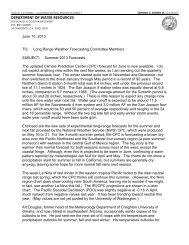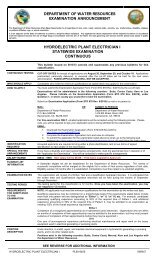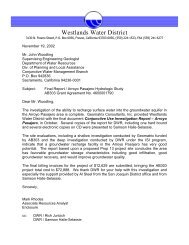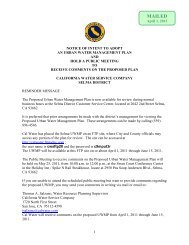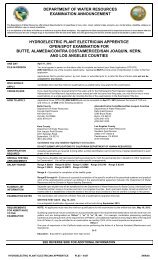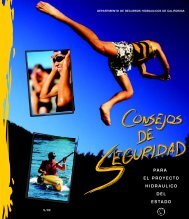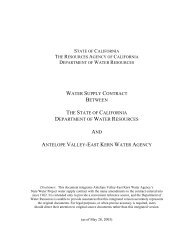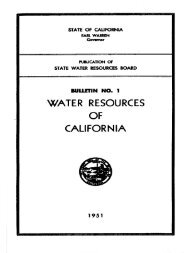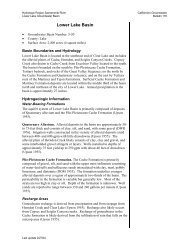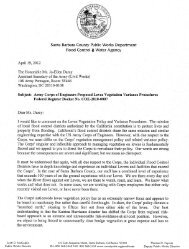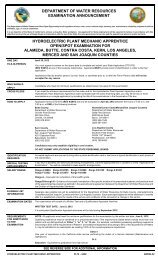January 14, 2008 Via Email (delores@water.ca.gov) and U.S. Mail ...
January 14, 2008 Via Email (delores@water.ca.gov) and U.S. Mail ...
January 14, 2008 Via Email (delores@water.ca.gov) and U.S. Mail ...
Create successful ePaper yourself
Turn your PDF publications into a flip-book with our unique Google optimized e-Paper software.
5500 Ming Avenue, Suite 490 Phone: (661) 398-4900<br />
Bakersfield, CA 93309 Fax: (661) 398-4959<br />
<strong>January</strong> <strong>14</strong>, <strong>2008</strong><br />
<strong>Via</strong> <strong>Email</strong> (<strong>delores@water</strong>.<strong>ca</strong>.<strong>gov</strong>) <strong>and</strong> U.S. <strong>Mail</strong><br />
Delores Brown, Chief<br />
Office of Environmental Compliance<br />
California Department of Water Resources<br />
901 “P” Street<br />
Sacramento, CA 958<strong>14</strong><br />
Re: Kern Water Bank Authority Comments on DEIR for Monterey Amendment<br />
to the State Water Project Contracts (Including Kern Water Bank Transfer)<br />
<strong>and</strong> Associated Actions as Part of a Settlement Agreement (Monterey<br />
Plus), by DWR, dated October, 2007. (SCH#: 2003011118)<br />
Dear Ms. Brown:<br />
I. INTRODUCTION<br />
These comments are submitted on behalf of the Kern Water Bank<br />
Authority (“KWBA”), a public agency, <strong>and</strong> its Member Entities, 1 in regard to the<br />
Draft Environmental Impact Report entitled “Monterey Amendment to the State<br />
Water Project Contracts (Including Kern Water Bank Transfer) <strong>and</strong> Associated<br />
Actions as Part of a Settlement Agreement (Monterey Plus)” (hereinafter,<br />
“Monterey Plus DEIR” or simply “DEIR”), dated October, 2007, prepared by the<br />
Department of Water Resources (“DWR”).<br />
II. BACKGROUND<br />
After execution of the Monterey Amendment, KWBA acquired title to the<br />
Kern Water Bank L<strong>and</strong>s (“KWB L<strong>and</strong>s”) consisting of about 20,000 acres<br />
immediately after the l<strong>and</strong>s were acquired by Kern County Water Agency<br />
(“KCWA”) from DWR. KWBA constructed <strong>and</strong> began operating <strong>and</strong><br />
administering a water banking project, known as the “Kern Water Bank,” on the<br />
KWB L<strong>and</strong>s under a Habitat Conservation Plan/National Community<br />
Conservation Plan (“HCP/NCCP”) <strong>and</strong> other environmental permits (collectively,<br />
1 KWBA’s Member Entities are: Dudley Ridge Water District, Kern County Water Agency –<br />
Improvement District No. 4, Semitropic Water Storage District, Tejon-Castac Water District,<br />
Westside Mutual Water Company, <strong>and</strong> Wheeler Ridge-Maricopa Water Storage District.
“Kern Environmental Permits”). 2 In 1997, KWBA filed a Notice of<br />
Determination (“NOD”) for the project based on its Initial Study <strong>and</strong> Addendum to<br />
the Monterey Agreement EIR (“Addendum”), prepared in accordance with CEQA,<br />
which evaluated <strong>and</strong> addressed the potential environmental impacts of the<br />
project’s construction, operation <strong>and</strong> administration. The Addendum provides for<br />
implementation of various mitigation measures by KWBA including a<br />
Memor<strong>and</strong>um of Underst<strong>and</strong>ing (“KWB MOU”) entered into on October 26, 1995,<br />
between KWBA, its member entities <strong>and</strong> the following entities adjoining the KWB<br />
L<strong>and</strong>s (“Adjoining Entities”): Buena Vista Water Storage District, Rosedale-Rio<br />
Bravo Water Storage District, Kern Delta Water District, Henry Miller Water<br />
District <strong>and</strong> West Kern Water District. 3<br />
In 2003, KWBA executed the above-mentioned Settlement Agreement<br />
arising out of litigation challenging the Monterey Amendment known as PCL v.<br />
DWR. The Settlement Agreement addresses the KWB L<strong>and</strong>s <strong>and</strong> various<br />
matters related to the Monterey Amendment. With respect to the KWB L<strong>and</strong>s,<br />
the Settlement Agreement provides that KWBA shall retain title to, <strong>and</strong> operate<br />
<strong>and</strong> administer, the KWB L<strong>and</strong>s including the Kern Water Bank, but proposes<br />
new “Restrictions on Use of KWB L<strong>and</strong>s” including non-development of about<br />
490 acres otherwise commercially developable under the HCP/NCCP (Sections<br />
V.A. & V.B.). 4 The Settlement Agreement provides further that the parties agree<br />
2 Prior to acquisition by KWBA, the KWB L<strong>and</strong>s were known as the “Kern Fan Element property,”<br />
property purchased by DWR for its planned development of the “Kern Fan Element,” a proposed<br />
groundwater banking project that was a part of a larger proposed groundwater banking project,<br />
known as the “Kern Water Bank.” (Appendix E, p. 5 fn. 1.) That Kern Water Bank project (not to<br />
be confused with KWBA’s subsequent Kern Water Bank project) consisted of the Kern Fan<br />
Element <strong>and</strong> several lo<strong>ca</strong>l elements, none of which were developed or implemented. (Id.)<br />
3 A copy of the NOD, Addendum <strong>and</strong> KWB MOU are enclosed. Appendix E states, at page 18,<br />
that “[t]he overall objective of the KWB MOU parties (KWBA, its Member Entities, <strong>and</strong> the districts<br />
surrounding the property [Adjoining Entities]) is that the ‘… design, operation <strong>and</strong> monitoring of<br />
the [Kern Water Bank] Project be conducted <strong>and</strong> coordinated in a manner to insure that the<br />
beneficial effects of the Project to the Project Participants [KWBA Member Entities] are<br />
maximized but that the Project does not result in signifi<strong>ca</strong>nt adverse impacts to water levels,<br />
water quality or l<strong>and</strong> subsidence within the boundaries of Adjoining Entities.’ ” As more fully<br />
described in Appendix E, the KWB MOU provides for various measures to protect lo<strong>ca</strong>l water<br />
levels <strong>and</strong> water quality, <strong>and</strong> provides for the establishment of the Kern Fan Monitoring<br />
Committee (consisting of the KWB MOU parties) to oversee project banking operations <strong>and</strong><br />
review an extensive monitoring program. (Appendix E, pp. 18-19.) The MOU also requires that<br />
all disputes concerning operation of the Kern Water Bank project shall first be submitted to the<br />
Monitoring Committee for review <strong>and</strong> analysis <strong>and</strong>, if not resolved, to arbitration. There are no<br />
disputes currently pending before the Monitoring Committee for resolution <strong>and</strong> no party has ever<br />
submitted any dispute to arbitration.<br />
4 Nothing in these comments is intended to suggest that KWBA’s right, title or interest in <strong>and</strong> to<br />
the KWB L<strong>and</strong>s or the Kern Water Bank is only interim or provisional due to the Settlement<br />
Agreement or otherwise. KWBA recognizes that the KWB L<strong>and</strong>s are covered by the interim<br />
implementation order provided for in the Settlement Agreement. However, that does not mean<br />
<strong>and</strong> the Settlement Agreement does not provide, nor was it the intention, that KWBA’s title was<br />
prior to the Settlement Agreement, is now or will in the future become provisional or interim in the<br />
absence of the Settlement Agreement, the order or otherwise. On the other h<strong>and</strong>, KWBA<br />
2
not to challenge the Addendum <strong>and</strong> that the Settlement Agreement shall not<br />
affect the continuing effectiveness of the Kern Environmental Permits which<br />
include the KWB MOU. (Section III.F.) Rather, the new EIR required by the<br />
Settlement Agreement is to include a study of the Kern Water Bank “in light of the<br />
Kern Environmental Permits.” (Id.)<br />
III. GENERAL COMMENTS<br />
The Monterey Plus DEIR includes an exhaustive analysis of the<br />
environmental effects of the Monterey Plus project -- the Monterey Amendment<br />
<strong>and</strong> Settlement Agreement. The DEIR was drafted with the advisory<br />
collaboration of DWR, the State Water Contractors, Planning <strong>and</strong> Conservation<br />
League, Citizens Planning Association of Santa Barbara, <strong>and</strong> Plumas County<br />
Flood Control <strong>and</strong> Water Conservation District. The analysis in the Monterey<br />
Plus DEIR concludes, among other things, that:<br />
There have been no signifi<strong>ca</strong>nt environmental effects resulting from<br />
implementation of the Monterey Amendment from 1996 to present.<br />
In particular, transfer of the Kern Water Bank L<strong>and</strong>s to, <strong>and</strong> development,<br />
operation <strong>and</strong> administration of the Kern Water Bank by, KWBA did not<br />
result in any signifi<strong>ca</strong>nt effects on the environment.<br />
Moving into the future, with KWBA’s continued implementation of the<br />
mitigation measures as required by the existing CEQA Addendum <strong>and</strong><br />
HCP/NCCP, further development, operation <strong>and</strong> administration of the<br />
Kern Water Bank will not result in any signifi<strong>ca</strong>nt effects on the<br />
environment.<br />
KWBA supported implementation of the Monterey Amendment in 1996<br />
<strong>and</strong> the Settlement Agreement in 2003, <strong>and</strong> supports their continued<br />
implementation into the future. KWBA commends the Department for having<br />
prepared this thorough <strong>and</strong> signifi<strong>ca</strong>nt document. Below please find specific<br />
comments on matters in the DEIR that KWBA feels are in need of clarifi<strong>ca</strong>tion,<br />
further explanation <strong>and</strong>/or revision in connection with preparation the final EIR.<br />
In addition, attached as Exhibit “A” hereto are comments of a more techni<strong>ca</strong>l<br />
nature for your consideration. Finally, the State Water Contractors’ comments on<br />
the DEIR are incorporated herein by this reference.<br />
IV. SPECIFIC COMMENTS<br />
A. THE FINAL EIR SHOULD EXPLAIN THAT, IN EXCHANGE FOR THE<br />
KWB LANDS, EACH KWBA MEMBER CONTRIBUTED TO THE<br />
recognizes that the Settlement Agreement provides that the “Restrictions on Use of KWB L<strong>and</strong>s”<br />
(Section V.B.) are interim <strong>and</strong> will become final only if certain conditions occur as provided in the<br />
Settlement Agreement (Section V.F.) (see also, Comment IV.E. below).<br />
3
RETIREMENT OF 45,000 ACRE-FEET OF AGRICULTURAL TABLE<br />
A AMOUNTS<br />
The DEIR explains that Article 52 of the Monterey Amendment provided<br />
for transfer of the Kern Fan Element property (DEIR, § 4.4.3). The DEIR<br />
explains that Article 53 required Kern County Water Agency (“KCWA”) <strong>and</strong><br />
Dudley Ridge Water District (“Dudley Ridge WD”), both agricultural contractors,<br />
to collectively permanently retire 45,000 acre-feet of Table A amount (DEIR, §<br />
4.4.2). The DEIR on page 4-7 (the 2 nd sentence of the 1 st paragraph) states that<br />
Article 52 of the Monterey Amendment required the Department to convey the<br />
Kern Fan Element property to KCWA without any explanation why. To be more<br />
accurate <strong>and</strong> more complete, the final EIR should include the following two<br />
statements where appropriate.<br />
First, the final EIR should include a statement to the effect that the transfer<br />
of the KFE property was “in exchange for” the retirement of the 45,000 acre-feet.<br />
Principle 3 of the Monterey Agreement – Statement of Principles between<br />
the State Water Contractors <strong>and</strong> DWR, dated December 1, 1994 (“Monterey<br />
Agreement”) (enclosed), later implemented by the Monterey Amendment 5 , states:<br />
“The Kern Fan Element property …will be sold…to designated Ag<br />
Contractors. In exchange, 45,000 acre-feet of Ag water entitlements will<br />
be transferred to DWR <strong>and</strong> retired.” (Emphasis added.) (Monterey<br />
Agreement, p. 2, 3.)<br />
Consistently, the “Agreement for the Exchange of the Kern Fan Element of<br />
the Kern Water Bank by <strong>and</strong> between The Department of Water Resources of<br />
the State of California <strong>and</strong> Kern County Water Agency, dated December 13,<br />
1995,” (“Exchange Agreement”) on file with DWR, states:<br />
“Article 52 of the Monterey Amendments provides that the Department of<br />
Water Resources shall convey to agricultural contractors, which includes<br />
the Kern County Water Agency, the Property which constitutes the Kern<br />
Fan Element of the Kern Water Bank. Agency will procure <strong>and</strong> deliver<br />
45,000 acre feet of annual agricultural entitlements to the State. The<br />
exchange of those water entitlements <strong>and</strong> other provisions of the<br />
Monterey Amendments shall be the consideration for the transfer of the<br />
Property.” (Exchange Agreement, p. 1.) (Emphasis added.)<br />
5 The Monterey Amendment specifi<strong>ca</strong>lly required KCWA to relinquish 40,670 acre-feet <strong>and</strong><br />
Dudley Ridge WD to relinquish 4,330 acre-feet. (See DEIR, Volume II, Appendices, Amendment<br />
No. 23 (The Monterey Amendment) to Water Supply Contract between the State of California<br />
Department of Water Resources <strong>and</strong> Kern County Water Agency, pp. 35-43.) Consistent with<br />
Principle 3, the Monterey Amendment also reflects the relationship between the Kern Fan<br />
Element property transfer <strong>and</strong> the retirements. (Id., 29(e), pp. 62-63.)<br />
4
Also, Appendix E to the DEIR similarly states:<br />
“In accordance with the Monterey Amendment, the Department conveyed<br />
the KFE property to KCWA in exchange for KCWA <strong>and</strong> DRWD [Dudley<br />
Ridge WD] permanently retiring a total of 45,000 AF of agricultural Table A<br />
amounts.” (DEIR, Appendix E, p. 11.) (Emphasis added.)<br />
Second, where appropriate, the final EIR should include a statement to the<br />
effect that (consistent with the foregoing) each member of the KWBA (which<br />
entity acquired the Kern Fan Element property from KCWA <strong>and</strong> now operates the<br />
KWB L<strong>and</strong>s) in fact <strong>ca</strong>used the retirement of Table A amounts totaling 45,000<br />
acre-feet. 6<br />
We think that, in addition to providing greater factual accuracy <strong>and</strong><br />
completeness, including the two suggested additional statements in the body of<br />
the final EIR will hopefully correct a misimpression about the transfer of the Kern<br />
Fan Element property to KWBA that has apparently arisen <strong>and</strong> is held by some<br />
members of the public. That is, that the Monterey Amendment provides for the<br />
Kern Fan Element property to be “given away” or “gifted” to private interests, as<br />
some public comments on the DEIR stated or suggested. 7 The fact is: the Kern<br />
Fan Element property was transferred to KCWA <strong>and</strong> then KWBA, a public entity,<br />
in exchange for retirement of 45,000 acre-feet of Table A amount by the<br />
agricultural water users that formed the KWBA <strong>and</strong> other provisions of the<br />
Monterey Amendment. Each side gave something up in exchange for the<br />
benefits it received, <strong>and</strong> the Table A dem<strong>and</strong>s on the SWP system as a whole<br />
were reduced by the permanent retirements by agricultural contractors.<br />
B. THE FINAL EIR SHOULD CLARIFY THAT, WITH KWBA’S<br />
CONTINUED IMPLEMENTATION OF MITIGITION MEASURES<br />
REQUIRED BY A PRE-EXISTING CEQA ADDENDUM AND<br />
HCP/NCCP, THE PROJECT ACTIVITIES RELATIVE TO THE KERN<br />
WATER BANK WILL NOT RESULT IN SIGNIFICANT IMPACTS,<br />
THUS NO MITIGATION MEASURES ARE REQUIRED BY CEQA<br />
Under the project, Kern Water Bank operations are to continue in<br />
accordance with the Addendum <strong>and</strong> Kern Environmental Permits including the<br />
HCP/NCCP (Settlement Agreement, III.F. & V.B.). KWBA previously<br />
6<br />
The precise amounts retired by each KWBA member are shown in Table 3 on page 17 of<br />
Appendix E.<br />
7<br />
For example, see the enclosed press release on the DEIR by the Planning <strong>and</strong> Conservation<br />
League <strong>and</strong> the transcripts from the public hearings conducted by DWR on the DEIR. There<br />
were also public comments in the public hearings on the DEIR stating or suggesting that the<br />
Monterey Amendment transfers the Kern Fan Element from “public” to “private” ownership,<br />
thereby privatizing a public asset, for operation “behind closed doors.” To correct this erroneous<br />
view, the final EIR might also benefit from a statement about KWBA explaining that the KWBA is<br />
a “public” agency subject to opening meeting <strong>and</strong> other laws appli<strong>ca</strong>ble to public agencies<br />
generally.<br />
5
implemented <strong>and</strong> is already required to continue implementation of the mitigation<br />
measures provided for by the Addendum <strong>and</strong> the HCP/NCCP.<br />
1. Chapter 7.4-3 Re: Terrestrial Biologi<strong>ca</strong>l Resources.<br />
With respect to the 1996-2003 period analysis, the DEIR concludes<br />
KWBA’s implementation of the mitigation measures reduce potential impacts on<br />
terrestrial biologi<strong>ca</strong>l resources to a “less than signifi<strong>ca</strong>nt” level <strong>and</strong>, thus, no<br />
mitigation is required (DEIR, p. 7.4-26). With respect to the future analysis, the<br />
DEIR describes the same mitigation measures <strong>and</strong> assumes, correctly, that in<br />
the future KWBA will continue to implement those same mitigation measures <strong>and</strong><br />
less than signifi<strong>ca</strong>nt impacts will result (DEIR, pp. 7.4-27-31). Be<strong>ca</strong>use, in the<br />
future, the project will not result in signifi<strong>ca</strong>nt impacts to terrestrial biologi<strong>ca</strong>l<br />
resources with continued operation <strong>and</strong> administration of the Kern Water Bank by<br />
KWBA under pre-existing already implemented mitigation measures, the future<br />
analysis in the final EIR should also conclude that no mitigation is required. 8<br />
2. Chapter 7.13-3 Re: Cultural <strong>and</strong> Paleontologi<strong>ca</strong>l Resources.<br />
Similarly, with respect to the 1996-2003 period analysis, the DEIR<br />
concludes KWBA’s implementation of the mitigation measures reduce potential<br />
impacts on cultural <strong>and</strong> paleontologi<strong>ca</strong>l resources to a “less than signifi<strong>ca</strong>nt” level<br />
<strong>and</strong>, thus, no mitigation is required (DEIR, p. 7.13-21). With respect to the future<br />
analysis, the DEIR describes the same mitigation measures <strong>and</strong> assumes,<br />
correctly, that in the future KWBA will continue to implement those same<br />
mitigation measures <strong>and</strong> less than signifi<strong>ca</strong>nt impacts will result (DEIR, p. 7.12-<br />
22). Be<strong>ca</strong>use, in the future, the project will not result in signifi<strong>ca</strong>nt impacts to<br />
cultural <strong>and</strong> paleontologi<strong>ca</strong>l resources with continued operation <strong>and</strong><br />
administration of the Kern Water Bank by KWBA under pre-existing already<br />
implemented mitigation measures, the future analysis in the final EIR should also<br />
conclude that no mitigation is required (see footnote 8).<br />
C. NO PROJECT ALTERNATIVES 1, 3 AND 4 SHOULD RECOGNIZE<br />
THAT THE KERN FAN ELEMENT PROPERTY MAY HAVE BEEN<br />
USED FOR SOMETHING OTHER THAN A STATE-OWNED WATER<br />
BANK, IF THE PROJECT HAD NOT BEEN IMPLEMENTED<br />
8 By definition, mitigation measures are changes or alterations to the proposed project required to<br />
mitigate or avoid signifi<strong>ca</strong>nt effects on the environment (Public Resources Code § 21081(a)(1);<br />
see also, Public Resources Code § 21081.6(a)(1) (reporting or monitoring program is only for<br />
changes to the project to mitigate or avoid signifi<strong>ca</strong>nt project impacts).) KWBA has implemented<br />
<strong>and</strong> must continue implementation of the pre-existing mitigation measures pursuant to a separate<br />
CEQA document, the Addendum, <strong>and</strong> the HCP/NCCP, <strong>and</strong>, with such implementation, no<br />
signifi<strong>ca</strong>nt effects will result from Kern Water Bank operations under the proposed project. Thus,<br />
no changes or alterations to the project are necessary to mitigate or avoid environmental impacts<br />
<strong>and</strong> further mitigation measures are not warranted by CEQA.<br />
6
No project alternatives 1, 3 <strong>and</strong> 4 assume that the Kern Fan Element<br />
property would have been developed by the state <strong>and</strong> operated as a state-owned<br />
water bank, if the project had not been implemented in 1996. The purpose of<br />
describing <strong>and</strong> analyzing a no project alternative is to allow decisionmakers to<br />
compare the impacts of approving the proposed project with the impacts of not<br />
approving the proposed project. 9 The no project alternative <strong>ca</strong>n include future<br />
actions, but only if they are “reasonably expected to occur in the foreseeable<br />
future if the project was not approved.” 10 In selecting a no project alternative,<br />
CEQA also provides that “where failure to proceed with the project will not result<br />
in preservation of existing environmental conditions, the analysis should identify<br />
the practi<strong>ca</strong>l result of the project’s non-approval <strong>and</strong> not create <strong>and</strong> analyze a set<br />
of artificial assumptions that would be required to preserve the existing physi<strong>ca</strong>l<br />
environment.” 11<br />
Appendix E to the DEIR explains in detail that, before the Monterey<br />
Amendment, DWR concluded that several impediments made development of a<br />
state-owned water bank on the Kern Fan Element “infeasible” (Appendix E, p. 4).<br />
These impediments included, but were not limited to, the fact that DWR <strong>and</strong><br />
KCWA could not reach agreement “on measures to comply with Water Code<br />
Section 11258, which required approval of lo<strong>ca</strong>l agencies for development of” a<br />
state-owned water bank in Kern County (Appendix E, p. 4). Based on the DEIR,<br />
there is still no reason to believe that a state-owned water bank on the Kern Fan<br />
Element property would have been reasonably expected to occur if the project<br />
had not been implemented in 1996. At a minimum, Chapter 11 (perhaps in<br />
paragraph 11.6 <strong>and</strong> endnote 1) of the final EIR should recognize <strong>and</strong> explain the<br />
various reasons why DWR previously concluded a state-owned water bank was<br />
infeasible including that it was not able to comply with Water Code section<br />
11258, before both the Monterey Agreement <strong>and</strong> the Monterey Amendment.<br />
D. POTENTIAL ENVIRONMENTAL EFFECTS RESULTING FROM A<br />
STATE-OWNED WATER BANK SHOULD BE ADDRESSED<br />
FURTHER OR CLARIFIED IN THE FINAL EIR<br />
The DEIR at least suggests that the Monterey Amendment provision<br />
consenting to contractors’ storage of Article 21 <strong>and</strong>/or other SWP water outside<br />
their respective service areas (Article 56), in the future, may contribute to<br />
reduction of Delta outflow <strong>and</strong> have a signifi<strong>ca</strong>nt effect on Delta fishery resources<br />
(DEIR, 7.3-55). This raises the following question: is this also the <strong>ca</strong>se for a<br />
state-owned water bank which, presumably, may be used to store some Article<br />
21 <strong>and</strong>/or other SWP water outside contractors’ service areas <strong>and</strong>, if not, why?<br />
The answer to this question is not clear to us from our reading of the DEIR <strong>and</strong><br />
9 CEQA Guidelines § 15126.6(e)(1).<br />
10 CEQA Guidelines § 15126.6(e)(2).<br />
11 CEQA Guidelines § 15126.6(e)(3)(B).<br />
7
the question should be addressed further or clarified in the final EIR. 12 The<br />
public <strong>and</strong> decisionmakers should be fully informed of the environmental effects<br />
of a state-owned water bank (if it remains a part of no project alternatives 1, 3 or<br />
4), in comparison to environmental effects of the project.<br />
E. FOR ALTERNATIVES THAT ASSUME THE SETTLEMENT<br />
AGREEMENT WOULD NOT TAKE PLACE, THE FINAL EIR SHOULD<br />
RECOGNIZE THE POTENTIAL FOR COMMERCIAL DEVELOPMENT<br />
OF 490 ACRES OF KWB LANDS, AS PERMITTED BY THE<br />
HCP/NCCP<br />
No project alternative 2 (“NPA2”) assumes the transfer of the Kern Fan<br />
Element property to KCWA, but that the “Settlement Agreement…would not take<br />
place.” 13<br />
(DEIR, p. 11-1.) The Settlement Agreement prohibits development of<br />
490 acres of the KWB L<strong>and</strong>s that are otherwise commercially developable under<br />
the HCP/NCCP. Thus, wherever the DEIR assumes that the Settlement<br />
Agreement would not take place (e.g., NPA2), then the final EIR should at least<br />
recognize that up to 490 acres of the KWB L<strong>and</strong>s may be commercially<br />
developed in the future. Again, the public <strong>and</strong> decisionmakers need to be aware<br />
of this potential environmental consequence if the project were not approved.<br />
F. THE FINAL EIR SHOULD CLARIFY ALTERNATIVE 5 MAY BE<br />
LEGALLY INFEASIBLE<br />
The DEIR provides that alternative 5 is the same as the proposed project<br />
except that the Monterey water supply management practices would not be<br />
implemented (DEIR, p. 11-3). The DEIR then recognizes that “there is doubt<br />
about the institutional feasibility” of the alternative (DEIR, 11-3, <strong>and</strong> endnote 2).<br />
We think the final EIR should clarify further that there is also considerable doubt<br />
about the “legal” feasibility of alternative 5, <strong>14</strong> <strong>and</strong> that CEQA does not require a<br />
lead agency to consider or authorize it to implement legally infeasible<br />
alternatives. 15<br />
V. TECHNICAL AND OTHER COMMENTS<br />
For convenience, our more techni<strong>ca</strong>l comments are included in Exhibit<br />
“A,” attached hereto <strong>and</strong> incorporated herein by this reference. Also, the State<br />
Water Contractors’ comments on the DEIR are incorporated herein by this<br />
reference <strong>and</strong> made a part of these comments.<br />
12<br />
The DEIR should also address how DWR would comply with Water Code section 11258 <strong>and</strong><br />
how that would affect operation of a state-owned water bank.<br />
13<br />
The DEIR does not state whether the Settlement Agreement would remain in place under<br />
alternative 5.<br />
<strong>14</strong><br />
The DEIR does not explain how alternative 5 would or could legally be implemented in light of<br />
the existing water supply contracts. This should also be clarified in the final EIR.<br />
15 th<br />
See Kenneth Mebane Ranches v. Superior Court (1992) 10 Cal.App.4 276, 291; CEQA<br />
Guidelines § 15126.6(a).<br />
8
VI. CONCLUSION<br />
Once again, KWBA <strong>and</strong> its member entities support the continued<br />
implementation of the Monterey Amendment <strong>and</strong> Monterey Settlement<br />
Agreement <strong>and</strong> appreciate DWR’s efforts in preparation of the DEIR for the<br />
Monterey Plus project. KWBA <strong>and</strong> its member entities also appreciate the<br />
opportunity to comment <strong>and</strong> hope these comments are constructive <strong>and</strong> helpful<br />
in preparing the final EIR for project. If you have any questions or comments,<br />
please do not hesitate to contact us.<br />
Enclosures<br />
9<br />
Sincerely,<br />
Jonathan Parker<br />
General Manager
EXHIBIT “A”<br />
TECHNICAL COMMENTS TO<br />
KWBA COMMENTS ON MONTEREY PLUS DEIR<br />
Page ES-37, Table ES-1, Impact 7.8-3<br />
The second sentence is not accurate <strong>and</strong> should be revised to state: “Between<br />
1996 <strong>and</strong> 2003, an additional 4,080 acres were …” instead of 1,665 acres.<br />
(Appendix E, p. 21.)<br />
Page 6-22<br />
The 1 st sentence of the 2 nd paragraph is not correct <strong>and</strong> the last portion of it<br />
should be revised to state: “…agricultural contractors to M&I contractors (Article<br />
53).” (Monterey Amendment, Article 53.)<br />
Pages 7.4-5 through 7.4-10, Table 7.4-2<br />
Comment: Northern harrier (Circus cyaneus), osprey (P<strong>and</strong>ion haliaetus), <strong>and</strong><br />
white-tailed (black-shouldered) kite (Elanus leucurus) are regularly seen on the<br />
KWB L<strong>and</strong>s (formerly Kern Fan Element). However, surveys by the ESRT have<br />
not identified Buena Vista Lake shrew (Sorex ornatus relictus) on such l<strong>and</strong>s.<br />
Thus, Table 7.4-2 on page 7.4-9 should delete the “X” from the Buena Vista Lake<br />
Shrew with respect to the Kern Fan Element.<br />
Page 7.4-11, 2 nd paragraph, <strong>and</strong><br />
Page 7.5-3, 2 nd paragraph<br />
The text from Appendix E, page 6, paragraph 3, more accurately describes the<br />
fallowing of l<strong>and</strong> on the Kern Fan Element, as follows: “A Memor<strong>and</strong>um of<br />
Underst<strong>and</strong>ing was signed between the Department <strong>and</strong> KCWA on March 25,<br />
1987, that provided for the phase out of all agricultural production on the KFE<br />
property by the end of 1993. In fact, one of the tenants’ leases was terminated in<br />
1989. Then in 1991, at the peak of the drought, all the remaining tenant leases<br />
were terminated, <strong>and</strong> thereafter the agricultural l<strong>and</strong>s were fallowed.”<br />
Page 7.4-25<br />
The Kern Water Bank HCP/NCCP establishes permanent mitigation l<strong>and</strong>s on the<br />
KWB L<strong>and</strong>s. This includes a DWR Mitigation Parcel of 530 acres, <strong>and</strong> a KWBA<br />
Mitigation Parcel of 635 acres (Appendix E, p. 23). The DEIR refers to the 530acre<br />
conservation easement set aside for the Department of Water Resources,<br />
but does not mention the 635-acre conservation easement set aside for the<br />
KWBA. The KWBA 635-acre conservation easement should be mentioned here.<br />
10
Page 7.4-27, Mitigation Measures<br />
The following statement, which is included on page 7.13-22 for cultural<br />
resources, should be included in this section to clarify the status of mitigation<br />
measures for the KWB L<strong>and</strong>s: “Under the Settlement Agreement, the parties<br />
recognize that the Addendum has been completed <strong>and</strong> agree not to challenge<br />
the mitigation measures (Settlement Agreement, III.F).<br />
Page 7.5-13, 1996-2003<br />
The first paragraph in section 7.5-3 contains some inaccurate acreage numbers<br />
<strong>and</strong> should be revised to state: “At the end of 1995, approximately 3,034 acres<br />
of shallow percolation ponds existed in the Kern Fan Element. The KWBA<br />
subsequently constructed the Kern Water Bank Canal, a six-mile long earthen<br />
<strong>ca</strong>nal extending from the Kern River to the California Aqueduct. Between 1996<br />
<strong>and</strong> 2003, an additional 4,080 acres were converted to shallow percolation<br />
ponds, for a total of 7,1<strong>14</strong> acres in 2003 in the Kern Fan Element.” (See<br />
Appendix E, pp. 21-22.)<br />
Page 7.5-13, Future Impacts<br />
As noted above, between 1996 <strong>and</strong> 2003, the KWBA built approximately 4,080<br />
acres of percolation ponds, not 1,665 acres.<br />
Page 7.7-10, Future Impacts<br />
As noted above, between 1996 <strong>and</strong> 2003, the KWBA built approximately 4,080<br />
acres of percolation ponds, not 4,700 acres.<br />
Page 7.8-9, 1996-2003<br />
The first paragraph in section 7.8-3 contains some inaccurate acreage numbers<br />
<strong>and</strong> other information <strong>and</strong> should be revised to state: “Prior to 1996,<br />
approximately 3,034 acres of shallow percolation ponds existed in the Kern Fan<br />
Element. The KWBA also constructed the Kern Water Bank Canal, a six-mile<br />
long earthen <strong>ca</strong>nal extending from the Kern River to the California Aqueduct.<br />
Between 1996 <strong>and</strong> 2003, an additional 4,080 acres were converted to shallow<br />
percolation ponds, for a total of 7,1<strong>14</strong> acres in 2003 in the Kern Fan Element.”<br />
(See Appendix E, pp. 21-22.)<br />
Page 7.10-3, 1996-2003<br />
In the 3rd paragraph in section 7.10-1, the “<strong>and</strong>” between “Kern Water Bank<br />
Canal” <strong>and</strong> “a six-mile long earthen <strong>ca</strong>nal…” should be deleted. They are the<br />
same facility. (See Appendix E, p. 22.)<br />
Page 7.10-5<br />
Endnote 3 is missing.<br />
Page 7.11-5<br />
The 2nd paragraph in section 7.11-1 contains some inaccurate acreage numbers<br />
<strong>and</strong> other information <strong>and</strong> should be revised to state: “As mentioned previously,<br />
11
3,034 acres of recharge ponds existed in the Kern Fan Element. Kern Water<br />
Bank Authority (KWBA) also constructed the Kern Water Bank Canal, a six-mile<br />
long earthen <strong>ca</strong>nal extending from the Kern River to the California Aqueduct.<br />
Between 1998 <strong>and</strong> 2003, an additional 4,080 acres were converted to shallow<br />
recharge basins, for a total of 7,1<strong>14</strong> acres in 2003 in the Kern Fan Element.”<br />
(See Appendix E, pp. 21-22.)<br />
Page 7.12-6<br />
The Kern Fan Element property consists of 19,900 acres (not 20,526 acres)<br />
lo<strong>ca</strong>ted in Kern County southwest of Bakersfield. (In fact, KFE property includes<br />
a portion of the Kern River.) In 1995, there were no major structures on Kern<br />
Fan Element except for I-5, the Cross Valley Canal, <strong>and</strong> some ab<strong>and</strong>oned tanks<br />
<strong>and</strong> other oil field equipment.<br />
Page 7.12-13, 1996-2003<br />
The DEIR includes the following statement in the 1 st paragraph of section 7.12-3,<br />
which should be revised to more accurately state: “The Monterey Amendment<br />
<strong>ca</strong>lls for ownership of the Kern Fan Element to be transferred from the<br />
Department to the KCWA. The transfer agreement was entered in 1995 <strong>and</strong> the<br />
transfer closed escrow in 1996.”<br />
The DEIR also states in the same paragraph that: “The KCWA then transferred<br />
ownership to a new agency, the KWBA. The KWBA built a groundwater storage<br />
facility, the Kern Water Bank, to take advantage of a provision of the Monterey<br />
Amendment that enables SWP contractors to store water outside their service<br />
areas.” The last, highlighted portion of the sentence is largely inaccurate <strong>and</strong><br />
misleading. In fact, the Kern Water Bank is within the service area of all its<br />
member entities but for one, Dudley Ridge WD. Accordingly, the primary reason<br />
for KWBA’s acquisition of the KWB L<strong>and</strong>s <strong>and</strong> construction of a Kern Water Bank<br />
was not to take advantage of Article 56 of the Monterey Amendment. Rather,<br />
KWBA acquired the KWB L<strong>and</strong>s <strong>and</strong> constructed the Kern Water Bank primarily<br />
to ensure a more reliable water supply for its member entities, that is, storage of<br />
water during times of surplus in service area for later recovery during times of<br />
shortage <strong>and</strong> use in service area (see primary water conservation objective of<br />
HCP/NCCP)).<br />
Finally, the 2 nd paragraph is not accurate <strong>and</strong> should be revised to state:<br />
“Between 1996 <strong>and</strong> 2003, as part of the Kern Water Bank, approximately 4,080<br />
acres ….”<br />
Page 7.13-21<br />
In the 3rd paragraph in section 7.13-3, the “<strong>and</strong>” between “Kern Water Bank<br />
Canal” <strong>and</strong> “a six-mile long earthen <strong>ca</strong>nal…” should be deleted. They are the<br />
same facility. (See Appendix E, p. 22.)<br />
12
Page 7.15-2, Kern Fan Element<br />
The text from Appendix E, page 6, paragraph 3, more accurately describes the<br />
fallowing of l<strong>and</strong> on the Kern Fan Element. We recommend the following change<br />
to the 2 nd paragraph of section 7.15.2.1:<br />
“The Kern Fan Element consists of 19,900 acres of l<strong>and</strong> lo<strong>ca</strong>ted in Kern County<br />
southwest of Bakersfield. The Kern Fan Element was farmed for many years<br />
until the mid-1980s. A Memor<strong>and</strong>um of Underst<strong>and</strong>ing was signed between the<br />
Department <strong>and</strong> KCWA on March 25, 1987, that provided for the phase out of all<br />
agricultural production on the KFE property by the end of 1993. In fact, one of<br />
the tenants’ leases was terminated in 1989. Then in 1991, at the peak of the<br />
drought, all the remaining tenant leases were terminated, <strong>and</strong> thereafter the<br />
agricultural l<strong>and</strong>s were fallowed” (Appendix E, p. 6.)<br />
Page 7.15-9, 1996-2003<br />
In the 1st paragraph in section 7.15-3 on page 7.15-9, the “<strong>and</strong>” between “Kern<br />
Water Bank Canal” <strong>and</strong> “a six-mile long earthen <strong>ca</strong>nal…” should be deleted.<br />
They are the same facility. (See Appendix E, p. 22.)<br />
Miscellaneous:<br />
In various instances throughout the DEIR, the DEIR refers to the Kern Fan<br />
Element or KFE property when the reference should instead be to the Kern<br />
Water Bank or KWB l<strong>and</strong>s <strong>and</strong> visa versa. In these comments, KWBA has not<br />
attempted to identify or suggest revisions in all such instances. However, to be<br />
accurate, the property should be <strong>ca</strong>lled the Kern Fan Element property when<br />
owned by DWR <strong>and</strong> the property should be <strong>ca</strong>lled the KWB L<strong>and</strong>s after it was<br />
acquired by KWBA. The Final EIR should make necessary corrections in this<br />
regard.<br />
13
President<br />
John Van de Kamp<br />
President Emeritus<br />
Sage Sweetwood<br />
First Vice President<br />
Bill Yeates<br />
Senior Vice President<br />
Kevin Johnso<br />
n<br />
Secretary/Treasurer Bill Center<br />
1107 9th Street, Suite 360, Sacramento, CA 958<strong>14</strong> Phone: 916-444-8726 Fax: 916-448-1789<br />
Website: www.pcl.org <strong>Email</strong>: pclmail@pcl.org<br />
This letter is printed on 60% recycled fiber, 30% post consumer waste, acid free paper.<br />
Regional Vice Presidents<br />
Elisabeth Brown<br />
Jan Chatten-Brown<br />
Dorothy Green<br />
Phyllis Faber<br />
Rick Frank<br />
Rick Hawley<br />
Doug Linney<br />
David Mogavero<br />
Lynn Sadler<br />
Teresa Villegas<br />
FOR IMMEDIATE RELEASE Mindy McIntyre<br />
October 26, 2007 Water Program Manager<br />
mmcintyre@pcl.org<br />
office: 916-313-4518<br />
mobile: 916-541-8825<br />
PRESS STATEMENT<br />
State proposes to give away water resources<br />
Monterey Amendments Draft EIR Released<br />
Sacramento- Despite the recent crisis in the Delta <strong>and</strong> the Governor’s push for new dams, last<br />
week the Department of Water Resources (DWR) proposed to give away the largest water<br />
storage facility in the state <strong>and</strong> to eliminate drought safeguards for urban areas in California.<br />
DWR’s draft decision, revealed in the Monterey Plus Environmental Impact Report (EIR)<br />
(http://www.des.water.<strong>ca</strong>.<strong>gov</strong>/mitigation_restoration_branch/rpmi_section/projects/index.cfm),<br />
would require the State to permanently adopt State Water Project contract amendments, <strong>ca</strong>lled<br />
the “the Monterey Amendments,” negotiated in secret by DWR in 1994. The original behind<br />
closed doors deal was successfully challenged in a lawsuit by the Planning <strong>and</strong> Conservation<br />
League, the Citizens Planning Association of Santa Barbara, <strong>and</strong> Plumas County Flood Control<br />
<strong>and</strong> Water Conservation District (Planning <strong>and</strong> Conservation League v. Department of Water<br />
Resources (2000) 83 Cal.App.3d). While DWR has been allowed to operate under the Monterey<br />
Amendments provisionally since 1995, the PCL lawsuit forced DWR to analyze the impact of<br />
the amendments <strong>and</strong> to decide whether or not permanently to adopt the Monterey Amendments<br />
or to modify the proposed contract changes based on that analysis.<br />
If permanently adopted, the Monterey Amendments would fundamentally change how the State<br />
Water Project (SWP) operates. Specifi<strong>ca</strong>lly, the Monterey Amendments would:<br />
• Eliminate contract provisions that provide drought safeguards for urban areas. DWR’s<br />
own analysis shows that in dry years like 2001, water supplies for homes <strong>and</strong> businesses<br />
in urban areas will be reduced by over 400,000 acre-feet, (a reduction of 26% of total<br />
urban water deliveries from the SWP), if the Monterey Amendments are adopted.<br />
• Give away the State owned Kern Water Bank, the largest water storage facility in the<br />
State.<br />
• Eliminate the common-sense provision in the original contract which required DWR to<br />
determine the realistic yield of the SWP. Without a knowing the actual <strong>ca</strong>pacity of the<br />
SWP, DWR will continue to promise to deliver “paper water,” water which actually does<br />
not exist in the real world. Already, the promise of paper water has lead to over-
eliance on the water from the fragile Bay-Delta, over-pumping, inevitable cutbacks in<br />
water supplies, <strong>and</strong> ultimately decreased water supply reliability.<br />
• Transfer millions of dollars in costs to the taxpayers, while rebating millions to<br />
individual water agencies.<br />
• Encourage the over-pumping of Delta water in the winter <strong>and</strong> spring months, which has<br />
already, under the provisional use of the Monterey Amendments, contributed to the<br />
massive decline of the Delta smelt <strong>and</strong> other Bay Delta fish populations.<br />
PCL has long held that DWR’s provisional operations under the Monterey Amendments are<br />
directly related to the declines in the health of the Delta, <strong>and</strong> decreases in water supply reliability<br />
across the State. If permanently adopted, the Monterey Amendments would strip urban areas,<br />
including homes <strong>and</strong> businesses of their drought safeguards, forcing those areas to depend on<br />
delivery of “surplus” water from the Delta in wetter years. The recent fish declines in the Delta<br />
<strong>and</strong> the resulting ruling from Judge Oliver W. Wanger of the U.S. District Court in Fresno,<br />
demonstrate that the “surplus” water urban areas now dependent on is actually just “paper water”<br />
that <strong>ca</strong>nnot be delivered in the future.<br />
“PCL is outraged that despite the obvious impacts on California, DWR is proposing to adopt the<br />
Monterey Amendments on a permanent basis, stripping urban areas of their drought safeguards<br />
<strong>and</strong> giving away the State’s largest storage facility,” said Mindy McIntyre, Water Program<br />
Director at the Planning <strong>and</strong> Conservation League. “This is a terrible decision for California that<br />
will exacerbate the water problems we are already facing today.”<br />
The Planning <strong>and</strong> Conservation League is a nonpartisan, nonprofit alliance of individuals <strong>and</strong><br />
conservation organizations working at the state, lo<strong>ca</strong>l, <strong>and</strong> national levels to protect <strong>and</strong><br />
restore California's natural environment, <strong>and</strong> to promote <strong>and</strong> defend the public health <strong>and</strong><br />
safety of the people of California.<br />
End<br />
2



